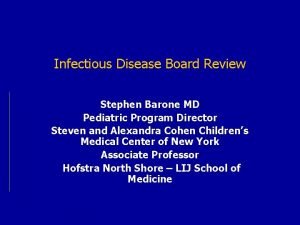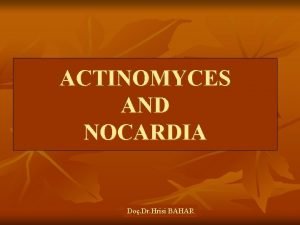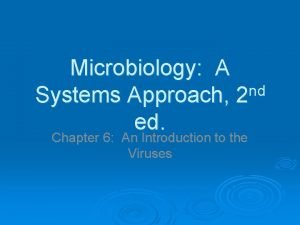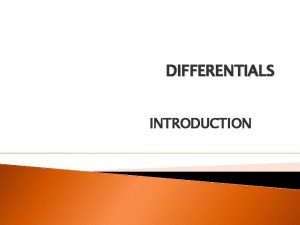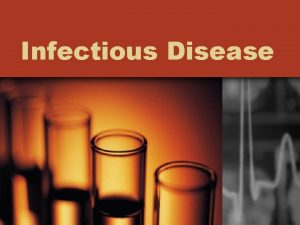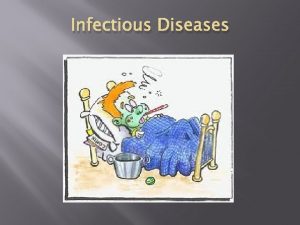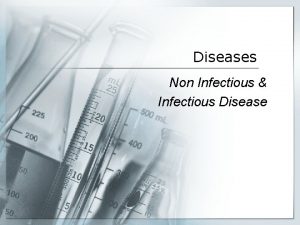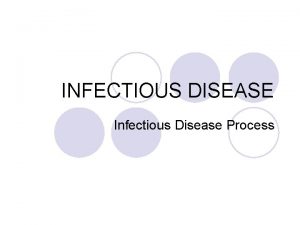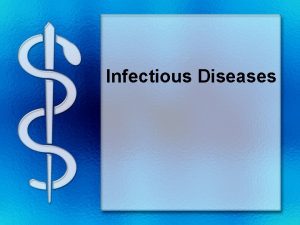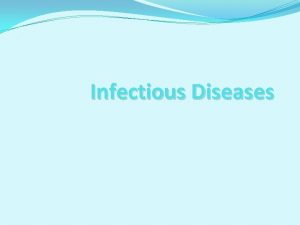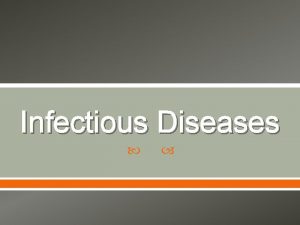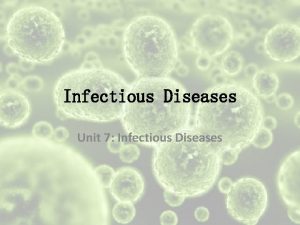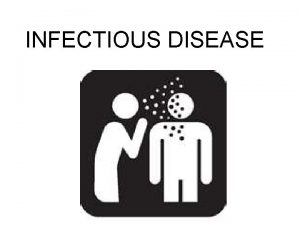Infectious Diseases Infectious Diseases Infectious diseases any disease
















- Slides: 16

Infectious Diseases

Infectious Diseases • Infectious diseases – any disease that is caused by an agent that can pass from one living thing to another.

Spread of Infection Person to person Handling money Epidemic Sneezing Sharing food or drink

Bacterial Infections • Bacteria-small, inside our bodies to protect us • Antibiotic – drug that kills or slows the growth of bacteria. – Alexander Fleming

Viral Infections • Small particle; outer shell and genetic material • Cannot reproduce like bacteria can • Invade a host cell and take over its machinery to make more viruses. • Symptoms – cold, sore throat, antibiotics do not work against them

Common Bacterial Infections • • • a. Strep Throat – streptococcus (bacteria). – Pain when you swallow. – Throat culture – Antibiotic for treatment – take the full course or infection could return b. Tuberculosis – Affects large population – kills 3 million each year – Spread by coughing – Cough, fever, weakness, sweating; PPD test done; 5 antibiotics given c. Sinus Infections – Sinuses fill with mucus and become infected with bacteria – Sinusitis – Symptoms – congestion, runny nose, fever, headache - Not contagious

Viral Infections • • • The Common Cold - Passed person to person; caused by many viruses - Sore throat, sneezing, runny nose, congestion Influenza – “the flu” - Fever, chills, body aches - Passed by touching, sneezing, sharing food/drink - Vaccine – substance used to keep a person from getting a disease. - Body develops immunity to any virus that infects you but the flu changes Mononucleosis - “Mono” – caused by virus called Epstein Barr - Passed through infected saliva – “Kissing disease”

Sexually Transmitted Diseases • STD’s – contagious infections that are spread from person to person by sexual contact. • STD’s – caused by bacteria, viruses, fungi, other infectious agents. Some are treatable, some have no cure. • Symptoms depend on infection – discharge, sores in genital area, rash, pain while urinating. • Some show no symptoms at all – called carriers.

STD’s Sexual abstinence – only sure way to keep from catching diseases. Common STD’s a. Chylamydia – bacterial, discharge, ab pain; Curable b. HPV – genital warts, some show no symptoms; treatable but not curable. Can cause cervical cancer. c. Genital herpes – painful blisters and sores in genital area. Cannot be cured. d. Gonorrhea – bacterial, some show no symptoms, discharge, pain while urinating. Curable e. Syphilis – bacterial, sores, fever, body rash, cured with antibiotics. Mental illness and death if left untreated. f. Trichomoniasis – itching, discharge. Cured with meds. Increased risk of HIV

HIV and AIDS – acquired immune deficiency syndrome. Caused by human immunodeficiency virus or HIV is a virus. AIDS is a disease resulting from infection by HIV virus. Incubation period – person has virus years before symptoms appear.

HIV and AIDS HIV originated in Africa. • a. Monkey’s infected with a virus and transferred to humans through blood. How is it spread? • a. Sexual contact • b. Sharing needles • c. Blood transfusion • d. Mother to child through breast milk or shared blood supply

Effects of AIDS and Treatment Effects of AIDS a. Shortened life span, immune system failing b. Pneumonia, breakdown of nervous system, digestive problems, skin sores Treatment • a. Incubation period – 10 years. • b. Combination therapy – slow reproduction of HIV virus. Only delay the process. Epidemic • a. Africa – 1 in 5 are infected • b. 40 million people infected with HIV and 22 million have died

Immune System • Immune System – organs and special cells that fight infection.

Physical Barriers that keep germs out

Internal Defenses • Internal defenses • a. Macrophages – engulf virus cells. • b. Mac signal T cells and B cells • c. B cells make antibiodies • d. Antibodies attach to other viruses and signals other cells to destroy viruses. • e. T cells destroy cells infected by viruses.

Prevent the spread • • • a. Wash your hands b. Avoid contact with those infected c. Don’t drink or eat after others. d. Eat balanced diet, sleep regularly, exercise regularly e. Get vaccinations.
 Certain infectious and parasitic diseases
Certain infectious and parasitic diseases Epidemiological triad
Epidemiological triad Stages of infectious disease
Stages of infectious disease Smallest infectious agents
Smallest infectious agents Infectious disease quality controls
Infectious disease quality controls Stridor
Stridor Stages of infection
Stages of infection Infectious disease
Infectious disease Chapter 26 infectious disease prevention and control
Chapter 26 infectious disease prevention and control Hennepin county infectious disease manual
Hennepin county infectious disease manual Communicable disease and non communicable disease
Communicable disease and non communicable disease Any to any connectivity
Any to any connectivity Pertanyaan terbuka
Pertanyaan terbuka There isn't any burger
There isn't any burger Infectious nucleic acid
Infectious nucleic acid Quizlet
Quizlet Infectious mononucleosis
Infectious mononucleosis





